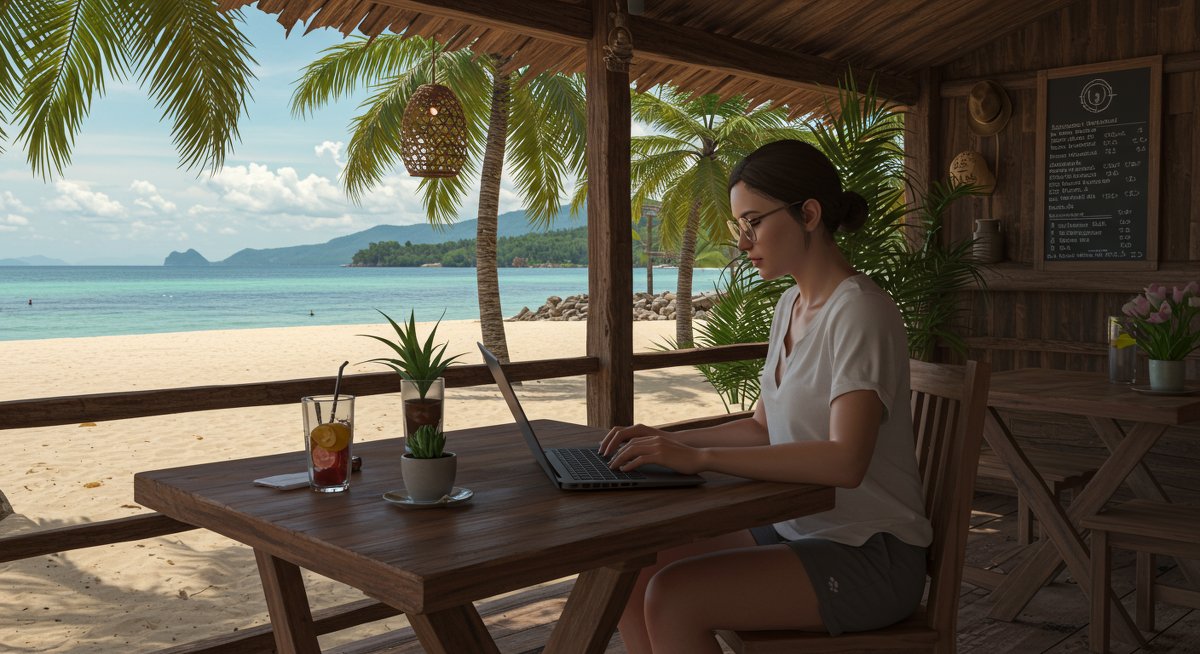
Why Embracing Budget Travel Matters for Your Nomad Journey
Embarking on a digital nomad journey is an exciting prospect, but the financial aspect can often seem daunting. The good news is that location independence doesn't have to mean breaking the bank. With smart planning and a willingness to embrace budget travel strategies, you can explore the world, work remotely, and enjoy a fulfilling nomad life without emptying your wallet. This guide is designed specifically for aspiring digital nomads, offering practical advice and actionable tips to make your travel dreams a reality. We'll dive into affordable destinations, money-saving travel hacks, and resources that empower you to travel longer, see more, and spend less. Whether you're just starting your journey or looking to optimize your existing nomad budget, this article will equip you with the knowledge to thrive.
Essential First Steps to Become a Digital Nomad
Before you book that plane ticket, it's crucial to lay a solid foundation for your budget travel adventure. This involves careful planning and preparation. First, assess your current financial situation. Determine your monthly income and expenses, and identify areas where you can cut back. Consider creating a detailed budget, and setting up automated savings. Secondly, choose a remote work setup that aligns with your financial goals. This might involve finding freelance gigs, securing a remote job, or building a business. Next, research your target destinations. Look into the cost of living, visa requirements, and internet access in each location. Finally, create a travel fund. Set aside a specific amount of money for travel expenses, including flights, accommodation, and daily spending. Automating your finances is key. Consider using a budgeting app like Mint or YNAB (You Need a Budget) to track your income and expenses. Automating your savings helps to ensure that you're consistently putting money aside for your travel fund, without relying on willpower.
Example 1: Budgeting with Apps
Many digital nomads use apps like Mint or YNAB (You Need a Budget) to track their spending and stick to their budgets. For instance, by categorizing expenses like accommodation, food, and transport, you can quickly identify where your money is going and pinpoint areas to save. Setting up alerts for when you're approaching your budget limits helps prevent overspending. Some apps also offer insights into your spending habits, enabling you to make informed decisions about your finances.
Example 2: Building a Travel Fund
To effectively build a travel fund, start by calculating your estimated monthly expenses in your target destinations. Include accommodation, food, transport, and entertainment. Set a savings goal based on this calculation, and then automate your savings. For instance, you can set up a recurring transfer from your checking account to your savings account each month. By making this process automatic, you'll consistently build your travel fund, without the need to manually transfer money or rely solely on willpower.
Example 3: Financial Preparation
Before taking the leap, it's essential to assess your financial readiness. This means understanding your income sources, identifying expenses, and setting financial goals. If you're freelancing, ensure you have a consistent flow of projects or clients. If you have a remote job, confirm your salary and benefits. Additionally, create a spreadsheet to track your income and expenses. This will help you gain clarity on your financial situation, allowing you to proactively manage your budget.
Common Beginner Challenges & How to Overcome Them
New digital nomads often face several challenges. One of the most common is managing finances. Many struggle to create and stick to a budget, leading to overspending and financial stress. To overcome this, use budgeting apps, track your expenses, and set realistic financial goals. Another challenge is finding affordable accommodation. High accommodation costs can quickly eat into your budget. Look for hostels, co-living spaces, or long-term rentals. Transportation costs can also be high. Consider using local public transport, walking, or cycling instead of taxis. Also, consider the initial setup costs of being a nomad. From tech gadgets, to flights and initial accommodation, things add up. Prepare well and have a backup plan.
Tips for Success (e.g., budgeting, finding remote jobs)
Success as a budget-conscious digital nomad comes down to careful planning and disciplined execution. First, create a detailed budget and stick to it. This includes tracking your income, expenses, and savings. Second, research affordable destinations with a low cost of living. Southeast Asia, Eastern Europe, and Latin America are popular choices. Third, look for remote work opportunities that pay well. Use job boards like RemoteOK or LinkedIn. Consider taking on freelance gigs to diversify your income. Finally, learn how to save money on accommodation, transportation, and food. Embrace free activities, cook your own meals, and utilize local transport. Leverage these tips to make your nomad dreams a reality.
Example 1: Using Local Transport
One way to save money is to use local transport. Instead of taking expensive taxis or ride-sharing services, consider using public buses, trains, or trams. In cities like Bangkok, Thailand, or Medellin, Colombia, local transport is a fraction of the cost of taxis. This not only saves money, but also provides a more authentic experience and allows you to interact with locals. Research transport options beforehand to ensure you understand the routes and costs.
Example 2: Cooking Your Own Meals
Eating out every day can quickly drain your budget. Cooking your own meals is a significant way to save money. Visit local markets to find fresh, affordable ingredients, and cook your meals in your accommodation. This is a great way to explore local culture, and it's typically much cheaper than eating out. Consider using online resources for simple recipes and meal planning ideas.
Example 3: Negotiating Accommodation
When looking for accommodation, try to negotiate the price, especially for longer stays. Many hotels, hostels, and rental apartments offer discounts for extended stays. Check sites like Hostelworld for hostel bookings and Airbnb for long-term rentals. By negotiating prices, you could save up to 20% on your accommodation costs, leading to significant savings over time.
Building a Sustainable Nomad Lifestyle
Building a sustainable nomad lifestyle involves more than just saving money. It also involves creating a healthy work-life balance, building a supportive community, and prioritizing your well-being. Establish a regular work schedule and create a dedicated workspace. Take breaks, and explore your surroundings. Connect with other nomads through online communities or co-working spaces. Prioritize your physical and mental health by exercising regularly, eating nutritious food, and getting enough sleep. Continuously evaluate and adapt your lifestyle to ensure it aligns with your values and goals. Remember, flexibility and adaptability are key.
Example 1: Maintaining Work-Life Balance
Maintaining a healthy work-life balance is critical for a sustainable nomad lifestyle. Set clear boundaries between work and leisure time. Establish a fixed work schedule, and stick to it. During your breaks, disconnect from work-related tasks and engage in activities you enjoy, whether it's exploring your surroundings, socializing, or pursuing hobbies. This helps prevent burnout and ensures a more fulfilling experience.
Example 2: Building a Nomad Community
Building a community of like-minded individuals can significantly enhance your nomad experience. Join online nomad communities like Facebook groups or Reddit forums to connect with others. Attend local meetups, co-working events, and workshops to meet people in person. Share your experiences, seek advice, and offer support to other nomads. A supportive community can provide valuable connections and opportunities, while easing feelings of isolation.
Example 3: Prioritizing Your Well-Being
Prioritizing your well-being is paramount for a sustainable nomad lifestyle. Make time for physical activity, such as walking, running, or joining a local gym. Eat nutritious meals and ensure you're getting enough sleep. Schedule regular breaks throughout your workday, and practice mindfulness or meditation to reduce stress. Cultivate healthy habits that support both your physical and mental health to ensure long-term enjoyment of your nomad journey.

Recommended Resources for New Nomads
Several resources can help aspiring digital nomads plan their budget travel adventures. Websites like Nomad List offer detailed information on the cost of living, internet speeds, and visa requirements for various cities worldwide. Use Google Flights or Skyscanner to find affordable flights. Websites like Hostelworld are great for finding budget accommodation, and Airbnb has a wide range of options. For budgeting, use apps like Mint and YNAB. For travel insurance, consider SafetyWing, designed specifically for nomads. Remember to use these resources wisely.
Quick Wins for Your First Nomad Trip
To get started, focus on small, manageable steps. Begin by researching a few potential destinations that align with your budget and interests. Next, find affordable accommodation options, such as hostels or co-living spaces. Then, explore free or low-cost activities in your chosen locations. Finally, create a basic budget to track your expenses and stay on track. By taking these initial steps, you can build momentum and gain confidence. Consider destinations in Southeast Asia or Latin America for your first trip. These regions offer a low cost of living and a vibrant culture. Pack light to avoid checked baggage fees, and research visa requirements in advance.
Next Steps in Your Location Independent Life
As you gain experience, refine your budgeting strategies, explore new destinations, and adapt your approach to maximize your location independence. Consider building a personal brand or launching a business to diversify your income streams. Network with other digital nomads, and leverage your experiences to inspire and support others. Always stay adaptable and open to new opportunities. Continue learning and evolving. Embracing change is crucial for long-term success.